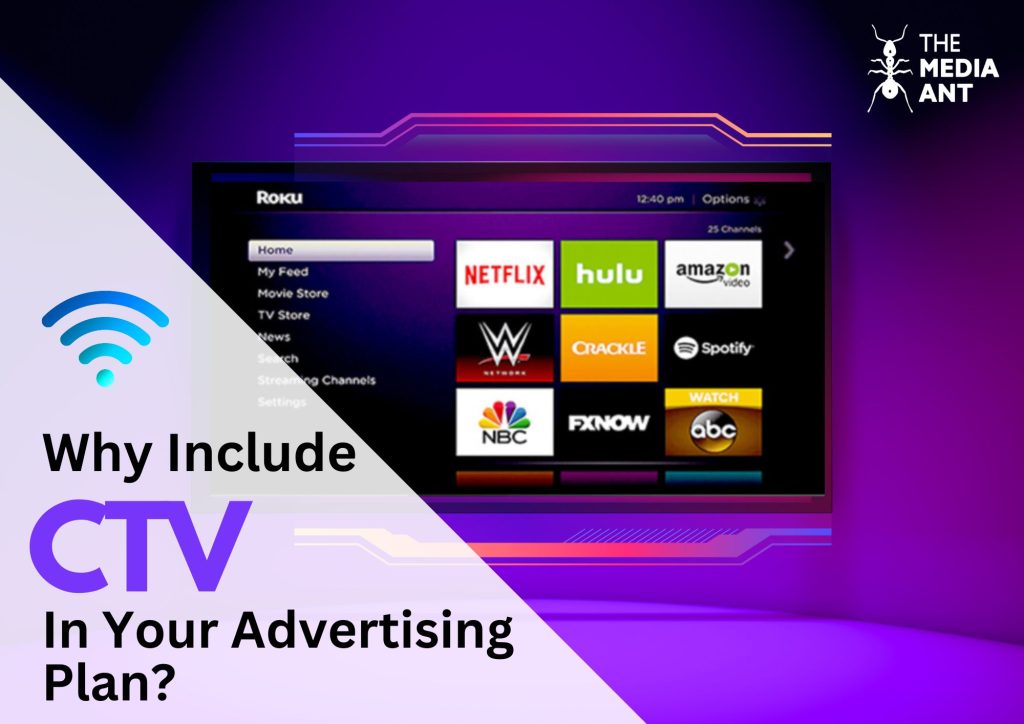The advertising industry is ever changing, and while technological advances have been a catalyst, certain things have remained relatively unchanged. TV advertising, in particular, has stuck to traditional methods. However, Connected TV (CTV) technology aims to disrupt this situation by introducing fresh, effective, and interactive advertising techniques to replace outdated ones.
This shift benefits consumers through a range of screen options and alternatives for cord-cutting, evident from the popularity of platforms like YouTube, Netflix, and Disney+. The glitzy option has coaxed advertisers to connect with unique audiences and enhance advertising efficiency. As audiences use various devices to consume content—spanning from smartphones and laptops to large TVs and gaming consoles—CTV advertising enables advertisers to reach them all at once. This merges the impact of traditional advertising with the precision of digital tools.
In this article we will discuss how CTV and traditional TV aren’t adversaries; they can complement each other. While CTV embraces digital innovation and targeted ads, traditional TV offers broad reach. Integrating both in an advertising strategy taps into a wider audience spectrum, combining precision and mass visibility for effective campaign outcomes.
1. How big is the CTV market in India?
The number of addressable TV homes in India is expected to expand from 20-22 million in 2022 to an impressive 40 million by 2025, reflecting the increasing penetration of smart TVs in Indian households.
2. CTV vs TV
While Connected TV (CTV) households have grown to around 20-22 million in 2023, they remain significantly fewer than the 210 million linear TV households recorded in 2020.
3. CTV vs Digital
With a staggering 759 million internet users, the 70 million users of Connected TV (CTV) appear modest. However, this number is steadily increasing, exemplifying the growing adoption and potential of CTV as it gains ground among online entertainment consumption choices, along with 424 million OTT users.
4. CTV reach in India
Indeed, if one looks at the CTV growth trend in households, there were 10-12 million CTVs in Jan 2022, which went up 23-25 million in Jan 2023, and crossed 35 million as of June 2023. This number is expected to reach 40 Mn by 2025.
5. Reasons for growth of CTV in India
The growth of CTV in India can be attributed to rising internet penetration, affordable smart TVs, diverse content options, and convenience, enticing users to shift from traditional TV to digital streaming.
6. CTV Advertising- Benefits
Connected TV (CTV) advertising offers precise targeting, reaching specific audiences based on demographics, behavior, and interests. It ensures ad viewability on larger screens, delivering an immersive experience. With real-time analytics, advertisers gauge campaign effectiveness, optimizing strategies. Its flexibility, engagement, and data-driven approach make CTV an appealing advertising avenue.
7. When should one opt for CTV advertising
In India, CTV’s reach is dwarfed by traditional TV, despite growing internet and OTT usage. Advertisers seeking incremental reach and precise geo-targeting should consider CTV, along with TV which can offer broader reach. Digital ads, along with CTV, can cater to premium audiences, offering diverse options for strategic targeting and impact.
8. Including CTV in TV planning
Incorporating CTV in TV advertising strategies leverages digital advancements to enhance traditional campaigns. It taps into evolving viewer preferences, extends reach to premium audiences, and offers interactive elements, enriching engagement and enabling advertisers to blend the best of both worlds for comprehensive brand exposure.
9. Including CTV in digital planning
Incorporating CTV in digital advertising broadens outreach beyond desktop and mobile devices. It harnesses the power of larger screens, offers immersive content experiences, and connects with audiences seeking high-quality, on-demand content, allowing advertisers to tap into a rapidly growing segment of digitally engaged viewers.
10. CTV Advertising: Case Study
CTV advertising might seem a bit overwhelming, but don’t you worry because we have a case study of Tanishq. In this elaborate case study we’ve explained in detail on how CTV advertising can be used effectively for incremental reach, better targeting and reaching out to premium audiences.
11. CTV Advertising Glossary
If you are thinking about incorporating CTV in your advertising plan, it is crucial that you know these simple terms related to CTV ads. We’ve explained in basic words the meaning of; pre-roll ads, mid-roll ads and programmatic advertising. Do not forget to check these out too.
How big is the CTV market in India?
Connected TV (CTV) adoption in India saw a rapid rise, with its share expected to reach 22% by 2027. The growth in CTV ad spends in the country is expected to increase, with a remarkable compound annual growth rate (CAGR) of 47% between 2022 and 2027.
The number of addressable TV homes in India is expected to expand from 20-22 million in 2022 to an impressive 40 million by 2025, reflecting the increasing penetration of smart TVs in Indian households. In Q3 of 2022 alone, India’s smart TV shipments surged by an impressive 38% year-on-year, demonstrating the rising demand for smart TVs in the market.
Smart TVs became the preferred choice among consumers in 2022, with 90% of TV units sold being smart TVs, indicating a significant shift towards more technologically advanced television sets.
Furthermore, the over-the-top (OTT) industry in India is set to witness a substantial increase, with a projected 42% rise in OTT users expected by 2025, leading to an estimated 600 million OTT viewers in the country by that year.
These statistics showcase the dynamic growth of the TV advertising and CTV markets in India, along with the rising popularity of smart TVs and the promising future of the OTT industry in the country. (Source: EY-FICCI Report 2023)
CTV landscape compared to Linear TV universe
According to GroupM’s 2023 This Year Next Year reports for the period 2022-2027, TV advertising spends in Global Markets are showing positive growth, primarily driven by brands investing more in Connected TV. The increasing convenience of Connected TV is attracting audiences towards this platform, while its addressability feature is enticing advertisers. This trend is not limited to global markets; in fact, India is emerging as a major player in the TV advertising market and is projected to become the third largest TV advertising market by 2024.
Hence, we can safely say that the CTV landscape is quite small when compared to TV, even though internet penetration in the country is experiencing steady growth.
TV reached 210 million households in 2020, as per the Broadcast Audience Research Council (BARC) TV Universe Estimates, translating into ~900 million individuals who watch TV.
Presently, there are approximately 20-22 Million Addressable TV homes in India, making up more than 10% of all TV homes. However, this number is set to rise significantly, reaching an estimated 40 Million Addressable TV homes in India by 2025.
These statistics indicate a gradual however slow shift in the advertising landscape, with Connected TV becoming dominant due to its convenience for audiences and addressability for advertisers. As India’s TV advertising market continues to grow at a robust rate, it presents a promising opportunity for brands and advertisers to tap into this evolving platform.
CTV landscape compared to digital universe
As per industry reports, there are 20-22 million internet-enabled connected televisions and the Indian OTT audience stands at 424 million people, out of which 119 million have active paid subscriptions. As CTV and OTT penetration increases in scale, marketers cannot ignore the advertising possibilities presented by this burgeoning media segment. It is estimated that by 2027, Indian brands will spend $395 million on CTV advertising.
CTV reach in India
If one looks at the CTV growth trend in households, there were 10-12 million CTVs in Jan 2022, which went up 23-25 million in Jan 2023, and crossed 35 million as of June 2023. CTV has a better mix of Younger Male audiences and higher penetration in Top 6, 1Mn+ and Urban markets.
Advertising spends on these connected TVs are estimated to swell from $86 mn in 2023 to $395 million by 2027 at 47% CAGR, says GroupM-Kantar study.
Reasons for growth of CTV in india
The growth of addressable TV homes in India is being driven by several key factors:
Quality Content on OTT Apps: The increasing popularity of content on OTT (Over-the-Top) apps has played a significant role. With the rise of streaming services like Netflix, Amazon Prime Video, and Disney+, viewers are now seeking diverse and on-demand content, which has encouraged more households to opt for internet-connected TVs and convert to addressable TV setups.
Increase in Smart TV Sales: The rapid surge in Smart TV sales has been a major catalyst for this growth. Smart TVs offer built-in internet connectivity and access to various streaming platforms, making it convenient for viewers to access digital content directly on their TV screens. As consumers upgrade their old televisions to Smart TVs, the number of addressable TV homes is steadily increasing.
Expansion of Broadband Connections: The expansion of broadband connections across the country has been a crucial enabler. Reliable and high-speed internet access is essential for smooth streaming experiences, and the continuous improvement of India’s internet infrastructure has made it more feasible for households to adopt addressable TV technology.
As more regions gain access to stable broadband connections, the potential for addressable TV homes is expected to grow further, with projections aiming for 40 million addressable TV homes in India by 2025. These three factors, combined with changing consumer preferences, are shaping the future of TV viewing in India and driving the growth of addressable TV homes in the country.
Benefits of CTV ads
- High View-Through-Rate & Better Targeting
Industry experts are of the opinion that Connected TV is a combination of the power of linear TV with the precision of programmatic ads, which makes it an even more viable ad option for advertisers. CTV is said to have a VTR of greater than 95% and 100%.
Shradha Agarwal, Strategy Head and COO of Grapes said, “One can measure CTV ads as well as optimize them in real-time.
Ad targeting is getting simpler these days because advertisers have data and preferences of shows that the viewers are watching.”
- Multiple advertising options available
Unlike linear TV, Connected TVs offer the scope of experimentation with the type of ad the advertiser wants to put out. Two basic formats of advertising are-
- Display/ Native inventory and
- Instream videos.
Advertisers also have an option to backlink the products to the ads, which in future may even support content-commerce.
Instream video ads on apps and OTT are quite popular, with their scope to grow with banner ads on the home screens too.
This is an ad option space that TV brands like Xiaomi & Samsung as well as portable streaming devices such as Amazon Fire Stick are trying to fill.
India is still young when it comes to CTV viewership but it is evolving fast and is on a rise, as we have discussed earlier.
We believe that there is potential for more growth. Industry sectors like real estate are going for banners and home page ads.
Slowly and undeviatingly content tech is becoming the next big thing, this means there’s room for innovation in terms of customization and user interaction.
- Premium audience
The viewers of connected television generally belong to high economic backgrounds, they are the premium audience. This mass of customers is someone who is likely to make more purchases. According to the FICCI-EY report by 2025 Connected TV is expected to reach 40 million viewers, and most of the viewers belong to the urban areas.
- Unique opportunities
In addition to flexible pricing, CTV reporting is more robust than you typically get across linear TV buys. Advertisers can see what audience segments of different networks so they know who is viewing their ads. Another unique opportunity advertisers have is to run high-impact creative across CTV.
When should one opt for CTV advertising?
If an advertiser wants to target specific characteristics such as high income, geo-targeting, metro-centric, and top of funnel audiences, CTV (Connected TV) advertising can be an effective strategy. Let’s elaborate on each point:
High Income: CTV advertising allows advertisers to target audiences based on demographics, including income levels. High-income individuals are more likely to afford premium services and products, making them an attractive target for certain brands. CTV platforms often collect user data, which can be utilized to serve ads to specific income groups, ensuring that the advertisements reach the intended audience.
Geo-Targeting: Geo-targeting refers to the ability to deliver ads to users based on their geographical location. CTV platforms can leverage IP addresses or device GPS data to determine users’ locations accurately. Advertisers can use this capability to target specific regions, cities, or even neighborhoods with tailored advertisements, ensuring that their messages are relevant to local audiences.
Metro-Centric: CTV advertising is particularly advantageous in metro-centric areas where there is a high concentration of population and internet-connected devices. Metropolitan regions offer a more diverse and tech-savvy audience, making them ideal for CTV campaigns. Advertisers can reach a large number of potential customers in densely populated urban areas through CTV, where traditional TV may not be as effective due to cord-cutting trends.
Top of Funnel: Top of funnel refers to the initial phase of the buyer’s journey, where potential customers are just becoming aware of a product or service. CTV advertising is an excellent medium for brand awareness campaigns, as it allows advertisers to display engaging video ads to a broad audience. Through sight, sound, and motion, CTV ads can make a lasting impression on viewers and create brand recall. Top-of-funnel advertising aims to build brand recognition and capture the attention of potential customers before they move further down the sales funnel.
Overall, CTV advertising offers precise targeting capabilities and the opportunity to engage with a tech-savvy, affluent, and diverse audience. By combining the benefits of high-income targeting, geo-targeting, metro-centric focus, and top-of-funnel awareness, advertisers can create more effective and personalized campaigns that resonate with their desired audience on CTV platforms.
Including CTV advertising in TV plan
“Cord cutters” and “cord shavers” are terms used to describe individuals or households that are either abandoning traditional cable or satellite television services altogether (cord cutting) or reducing their reliance on such services while still maintaining some level of subscription (cord shaving). These trends have significant effects on TV plans and the television industry as a whole. Here’s how:
Cord Cutters: Cord cutters are individuals who choose to cancel their traditional cable or satellite TV subscriptions and instead rely on internet-based streaming services for their entertainment needs. This movement is driven by several factors:
- Cost Savings: Streaming services often offer more affordable subscription options compared to traditional cable or satellite packages, which can include numerous channels that subscribers don’t actually watch.
- Flexibility: Streaming services allow viewers to choose content a la carte, enabling them to watch what they want, when they want, without being tied to a fixed schedule.
- On-Demand Content: Many streaming platforms provide a vast library of on-demand content, including TV shows, movies, and original programming.
- No Contracts: Unlike cable or satellite contracts, most streaming services offer month-to-month subscriptions, allowing users to cancel anytime without penalties.
The effect on TV plans: Cable and satellite TV providers may experience a decline in subscribers, leading to the need to adapt their offerings, provide better value, and potentially offer streaming options themselves.
Cord Shavers: Cord shavers are individuals who keep their traditional TV subscriptions but downsize to smaller, cheaper packages. They might reduce the number of channels they subscribe to while still maintaining some level of cable or satellite service. This is often a response to rising subscription costs and a desire to trim unnecessary expenses.
The effect on TV plans: To retain cord shavers, cable and satellite providers might need to introduce more flexible and customizable packages that allow customers to select the channels they truly want, rather than bundling them with less relevant ones.
- Streaming Services Boom: The rise of cord cutters has fueled the growth of streaming services like Netflix, Hulu, Amazon Prime Video, Disney+, and many others. These services are creating original content and competing with traditional TV networks for viewership.
- Content Distribution Changes: As more viewers shift to streaming, content creators and networks are adapting by making their content available online and negotiating deals with streaming platforms.
- Advertising Shift: Advertisers are adjusting their strategies to reach viewers who are shifting away from traditional TV. They’re exploring opportunities for digital advertising on streaming platforms.
In response to these shifts, traditional TV providers have been prompted to evolve their offerings, improve customer experience, and innovate to remain competitive in an increasingly digital landscape. The TV industry is experiencing a significant transformation as a result of these changes in viewing habits.
Including CTV advertising in Digital plan
Digital advertising has made into every brand’s marketing strategy and why not, considering the growing internet penetration in India and cost-effectiveness of the platforms. A digital plan helps when a brand’s objectives are:
- Reach and Frequency: Digital ads are an effective way to achieve high reach and frequency. Reach refers to the number of unique individuals who see an ad, while frequency refers to how often those individuals see the ad. Digital platforms allow you to target a wide audience and control how frequently your ads are shown to them.
- Mobile vs. CTV (Connected TV): Mobile devices generally provide higher reach and frequency compared to Connected TV (CTV) devices. This could be due to the fact that people often carry their mobile devices with them and use them throughout the day. CTV, on the other hand, is typically used in a more leisurely or stationary setting, potentially leading to lower reach and frequency.
- Non-Domestic Audience: Digital ads are excellent for reaching both domestic and international audiences. With proper targeting settings, you can tailor your ads to specific geographic locations, languages, and other demographic factors, making it easier to engage with non-domestic audiences.
- Driving Traffic: Digital ads are often used to direct traffic to a website, landing page, app, or other digital platform. This is particularly useful for increasing brand visibility, promoting products or services, and ultimately converting users into customers or leads.
Here’s how CTV advertising fits into the digital ad plan:
- Impact property: Connected TV (CTV) has emerged as a powerful impact property for brands, offering an enhanced and immersive viewing experience that can significantly benefit their marketing efforts. In fact, in a brand lift study by Kantar it was found that CTVs are more effective than mobile devices when it comes to brand recall and impact.
The study by Kantar for an automobile brand who advertised on both CTV and mobile suggested that their impact on CTV was 2X than that of mobile devices.
- Geo-Targeting: CTV advertising platforms allow precise geo-targeting capabilities based on IP addresses or device GPS data. Advertisers can deliver tailored ads to specific locations, cities, or regions, ensuring that their messages resonate with the local audience. This feature enables better targeting efficiency and minimizes wastage of ad spend on irrelevant audiences.
- Premium Audience: CTV platforms often attract a premium audience that is affluent, tech-savvy, and more engaged with digital content. By advertising on CTV, brands can reach this desirable demographic, ensuring that their products or services are seen by a segment that is likely to have higher purchasing power and brand receptiveness.
- Metro-Centric Targeting: CTV is particularly effective in metro-centric areas where internet-connected devices are prevalent. Targeting metros through CTV enables advertisers to connect with urban audiences, who are often trendsetters and influencers, and can positively impact brand awareness and engagement.
- Mass Reach: CTV offers significant mass reach, similar to traditional TV advertising. With the increasing popularity of CTV and the growing number of users consuming digital content on large screens, advertisers can tap into a vast and diverse audience. This mass reach ensures that the ad campaign gains exposure to a broad segment of the population.
- Incremental Reach: CTV advertising can complement other digital advertising efforts, such as social media or display ads. By adding CTV to the mix, advertisers can achieve incremental reach, ensuring that their message reaches audiences who may not be reached through other digital channels alone.
Incorporating CTV advertising in the digital ad plan provides a comprehensive and well-rounded approach to target audiences with varying preferences and behaviors. While other digital channels are valuable, CTV uniquely caters to the preferences of premium, urban, and tech-savvy audiences while offering the reach and scale necessary for mass and incremental reach strategies.
By leveraging the strengths of CTV in geo-targeting, premium audience reach, metros, and mass reach, the digital ad plan can deliver a more effective and impactful campaign for the advertiser’s objectives.
Example: Tanishq launches a new product
Objective: Brand awareness for their new product
Target Audience: Urban working women
Including both CTV (Connected TV) and traditional TV in their advertising plan can be a smart and effective approach for Tanishq to achieve their objective of brand awareness and target the urban working women audience. Here’s why:
- Broad Reach: Traditional TV has a wide reach and continues to be a popular medium for mass communication. It allows Tanishq to reach a diverse audience, including urban working women and other potential customers who may not be active CTV users or have not fully transitioned to digital streaming platforms. By advertising on traditional TV, Tanishq can reach a large portion of the population, ensuring maximum exposure to their new product.
- Brand Building: TV advertising, whether on CTV or traditional TV, offers the advantage of sight, sound, and motion, enabling Tanishq to create impactful and memorable brand messages. For a new product launch, it’s crucial to build brand awareness and establish an emotional connection with the target audience. TV ads, with their storytelling capabilities, can help in forging that connection and leave a lasting impression on viewers.
- Urban Working Women Targeting: CTV advertising is an excellent way to specifically target urban working women, given their high adoption of internet-connected devices and streaming services. CTV platforms allow for precise audience targeting based on demographics, interests, and behavior, ensuring that Tanishq’s ads reach the right audience at the right time. By combining CTV with traditional TV, Tanishq can create a comprehensive media strategy that reaches both CTV-savvy urban working women and a broader, diverse TV audience.
- Complementing Media Mix: Using a combination of CTV and traditional TV ensures a complementary media mix that maximizes the impact of the advertising campaign. While CTV reaches a more targeted and tech-savvy audience, traditional TV provides a broader reach and allows Tanishq to reinforce its message across various demographics. The two mediums working together can amplify the overall reach and effectiveness of the campaign.
- Measurable Performance: Both CTV and traditional TV advertising can offer data and analytics to measure the campaign’s performance. Advertisers can track metrics such as impressions, views, engagement, and reach, enabling Tanishq to assess the success of their brand awareness campaign and make data-driven decisions for future marketing strategies.
In summary, by including both CTV and traditional TV in their advertising plan, Tanishq can benefit from the broad reach of traditional TV, while leveraging the precise targeting and engagement capabilities of CTV to effectively reach their target audience of urban working women and create a strong brand awareness for their new product.
CTV advertising Glossary
In Connected TV (CTV) advertising, there are several ad options available to advertisers. These ad formats are designed to engage viewers effectively and provide opportunities for brands to deliver their messages in an engaging and non-intrusive manner. Some common ad options in CTV advertising include:
- Pre-Roll Ads: Pre-roll ads are short video advertisements that play before the selected content starts streaming. They are similar to traditional TV commercials and typically last for a few seconds to a minute. Viewers have the option to skip these ads after a brief period, but they provide an opportunity for advertisers to capture the audience’s attention before they watch their desired content.
- Mid-Roll Ads: Mid-roll ads are video ads that appear in the middle of the streaming content, much like commercial breaks during traditional TV programming. These ads are designed to keep viewers engaged during longer videos, such as TV shows or movies, and can be more effective in terms of ad retention.
- Programmatic Advertising: Programmatic advertising allows advertisers to use data-driven technology to deliver targeted ads to specific audiences based on demographics, interests, and behavior. It enables efficient ad buying and targeting, ensuring that the right ad is shown to the right viewer at the right time.
Conclusion
While Connected TV (CTV) is undeniably trending, its landscape remains dwarfed by traditional TV’s vast reach. Despite rising internet penetration and OTT users in India, CTV users remain limited. Yet, for advertisers seeking incremental reach to augment TV campaigns, CTV becomes a strategic choice. The power lies in combining both platforms for extended coverage.
Moreover, CTV’s integration into a digital plan offers impact and access to premium audiences. In this nuanced advertising ecosystem, the art lies in orchestrating a harmonious blend of CTV, traditional TV, and digital mediums, harnessing their unique strengths to achieve comprehensive and effective brand exposure.





